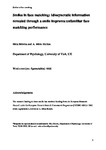Smiles in face matching: Idiosyncratic information revealed through a smile improves unfamiliar face matching performance
| dc.contributor.author | Mileva, Mila | |
| dc.contributor.author | Burton, Anthony Michael | |
| dc.date.accessioned | 2020-04-03T09:44:58Z | |
| dc.date.available | 2020-04-03T09:44:58Z | |
| dc.date.issued | 2018-11 | |
| dc.identifier.issn | 0007-1269 | |
| dc.identifier.issn | 2044-8295 | |
| dc.identifier.uri | http://hdl.handle.net/10026.1/15491 | |
| dc.description.abstract |
<jats:p>Unfamiliar face matching is a surprisingly difficult task, yet we often rely on people's matching decisions in applied settings (e.g., border control). Most attempts to improve accuracy (including training and image manipulation) have had very limited success. In a series of studies, we demonstrate that using smiling rather than neutral pairs of images brings about significant improvements in face matching accuracy. This is true for both match and mismatch trials, implying that the information provided through a smile helps us detect images of the same identity as well as distinguishing between images of different identities. Study 1 compares matching performance when images in the face pair display either an open‐mouth smile or a neutral expression. In Study 2, we add an intermediate level, closed‐mouth smile, to identify the effect of teeth being exposed, and Study 3 explores face matching accuracy when only information about the lower part of the face is available. Results demonstrate that an open‐mouth smile changes the face in an idiosyncratic way which aids face matching decisions. Such findings have practical implications for matching in the applied context where we typically use neutral images to represent ourselves in official documents.</jats:p> | |
| dc.format.extent | 799-811 | |
| dc.format.medium | Print-Electronic | |
| dc.language | en | |
| dc.language.iso | eng | |
| dc.publisher | Wiley | |
| dc.subject | face matching | |
| dc.subject | face recognition | |
| dc.subject | smile | |
| dc.subject | emotional expressions | |
| dc.title | Smiles in face matching: Idiosyncratic information revealed through a smile improves unfamiliar face matching performance | |
| dc.type | journal-article | |
| dc.type | Journal Article | |
| plymouth.author-url | https://www.webofscience.com/api/gateway?GWVersion=2&SrcApp=PARTNER_APP&SrcAuth=LinksAMR&KeyUT=WOS:000446318000010&DestLinkType=FullRecord&DestApp=ALL_WOS&UsrCustomerID=11bb513d99f797142bcfeffcc58ea008 | |
| plymouth.issue | 4 | |
| plymouth.volume | 109 | |
| plymouth.publication-status | Published | |
| plymouth.journal | British Journal of Psychology | |
| dc.identifier.doi | 10.1111/bjop.12318 | |
| plymouth.organisational-group | /Plymouth | |
| plymouth.organisational-group | /Plymouth/Faculty of Health | |
| plymouth.organisational-group | /Plymouth/Faculty of Health/School of Psychology | |
| plymouth.organisational-group | /Plymouth/REF 2021 Researchers by UoA | |
| plymouth.organisational-group | /Plymouth/REF 2021 Researchers by UoA/UoA04 Psychology, Psychiatry and Neuroscience | |
| plymouth.organisational-group | /Plymouth/REF 2021 Researchers by UoA/UoA04 Psychology, Psychiatry and Neuroscience/UoA04 Psychology, Psychiatry and Neuroscience MANUAL | |
| plymouth.organisational-group | /Plymouth/Users by role | |
| plymouth.organisational-group | /Plymouth/Users by role/Academics | |
| dc.publisher.place | England | |
| dc.identifier.eissn | 2044-8295 | |
| dc.rights.embargoperiod | Not known | |
| rioxxterms.versionofrecord | 10.1111/bjop.12318 | |
| rioxxterms.licenseref.uri | http://www.rioxx.net/licenses/all-rights-reserved | |
| rioxxterms.type | Journal Article/Review |


